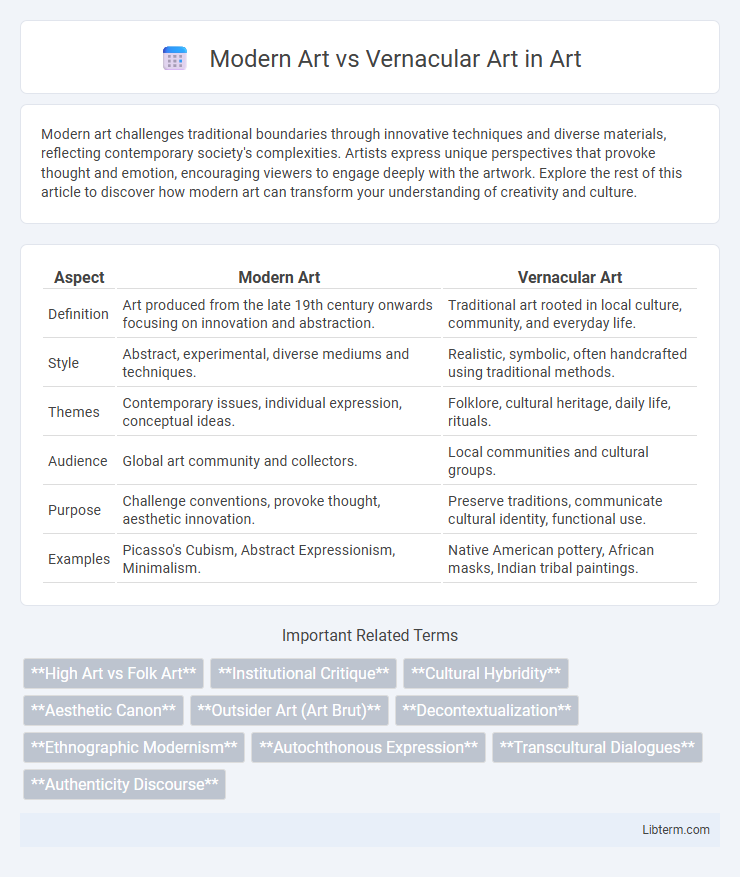Modern art challenges traditional boundaries through innovative techniques and diverse materials, reflecting contemporary society's complexities. Artists express unique perspectives that provoke thought and emotion, encouraging viewers to engage deeply with the artwork. Explore the rest of this article to discover how modern art can transform your understanding of creativity and culture.
Table of Comparison
| Aspect | Modern Art | Vernacular Art |
|---|---|---|
| Definition | Art produced from the late 19th century onwards focusing on innovation and abstraction. | Traditional art rooted in local culture, community, and everyday life. |
| Style | Abstract, experimental, diverse mediums and techniques. | Realistic, symbolic, often handcrafted using traditional methods. |
| Themes | Contemporary issues, individual expression, conceptual ideas. | Folklore, cultural heritage, daily life, rituals. |
| Audience | Global art community and collectors. | Local communities and cultural groups. |
| Purpose | Challenge conventions, provoke thought, aesthetic innovation. | Preserve traditions, communicate cultural identity, functional use. |
| Examples | Picasso's Cubism, Abstract Expressionism, Minimalism. | Native American pottery, African masks, Indian tribal paintings. |
Introduction to Modern Art and Vernacular Art
Modern Art, emerging in the late 19th and early 20th centuries, emphasizes innovation, abstraction, and breaking away from traditional techniques to reflect contemporary experiences and ideas. Vernacular Art, rooted in local cultures and everyday life, includes folk art, crafts, and indigenous expressions that embody community values and traditions. Understanding these distinctions highlights the contrast between formal artistic experimentation and culturally embedded creative practices.
Defining Characteristics of Modern Art
Modern Art is characterized by its break from traditional techniques and subjects, emphasizing innovation, abstraction, and experimentation with form and color. It often explores subjective experiences, symbolism, and new perspectives through movements like Cubism, Surrealism, and Abstract Expressionism. This art challenges conventional aesthetics by prioritizing individual expression and conceptual depth over realistic representation.
Unique Features of Vernacular Art
Vernacular art is distinguished by its deep roots in local culture, traditions, and everyday life, often created by anonymous or community-based artists rather than formal institutions. It emphasizes functional, symbolic, or ritualistic purposes, showcasing unique materials, techniques, and motifs that reflect the identity and history of specific regions or groups. Unlike modern art's emphasis on innovation and individual expression, vernacular art's value lies in its continuity, accessibility, and cultural authenticity.
Historical Origins and Cultural Contexts
Modern art emerged in the late 19th and early 20th centuries, rooted in European avant-garde movements that challenged traditional academic styles and embraced abstraction, experimentation, and individual expression. Vernacular art, by contrast, originates from localized, indigenous, or folk traditions, deeply embedded in community practices and cultural rituals passed down through generations. While modern art reflects global artistic dialogues and urbanization, vernacular art preserves cultural identity and social cohesion within specific historical and cultural contexts.
Influences and Inspirations
Modern Art draws heavily from industrialization, technological advances, and formal experimentation, reflecting urban life and global cultural exchanges. Vernacular Art is deeply rooted in local traditions, community narratives, and indigenous materials, emphasizing cultural identity and heritage. Both influence each other as Modern Art occasionally integrates vernacular motifs, while vernacular art adapts to contemporary social contexts.
Techniques and Materials Used
Modern art employs innovative techniques such as mixed media, digital manipulation, and abstract expressionism, often utilizing synthetic materials like acrylic paints, plastics, and industrial products to push creative boundaries. Vernacular art is rooted in traditional craftsmanship, using locally sourced, natural materials such as wood, clay, fabric, and plant dyes, emphasizing hand-made techniques passed down through generations. These distinct approaches highlight modern art's experimental and global nature versus vernacular art's cultural specificity and artisanal heritage.
Social and Political Implications
Modern art often reflects broader socio-political movements by challenging traditional norms and advocating for progressive ideologies, emphasizing individual expression and global narratives. Vernacular art, rooted in local customs and community identities, serves as a vehicle for preserving cultural heritage and resisting cultural homogenization imposed by dominant political powers. Both art forms function as powerful tools for social commentary, with modern art driving reformist discourse and vernacular art fostering solidarity and resistance within marginalized groups.
Audience Engagement and Accessibility
Modern art often targets a niche audience with specialized knowledge, utilizing abstract forms and complex symbolism that can challenge viewer interpretation. Vernacular art engages broader communities by reflecting everyday cultural experiences and using familiar iconography, enhancing accessibility and emotional connection. Audience engagement in vernacular art thrives on relatable content and communal participation, while modern art may prioritize conceptual depth and innovation over immediate accessibility.
Contemporary Relevance of Both Art Forms
Modern Art and Vernacular Art both hold significant contemporary relevance, reflecting diverse cultural narratives and societal values in today's globalized world. Modern Art challenges traditional aesthetics through innovative techniques and conceptual themes, influencing contemporary design, fashion, and digital media, while Vernacular Art preserves local heritage and community identity, fostering cultural continuity and social cohesion. The dynamic interplay between these art forms enriches contemporary creativity by blending global innovation with rooted traditions.
Bridging the Gap: Future Perspectives
Bridging the gap between Modern Art and Vernacular Art involves integrating contemporary techniques with traditional cultural expressions to foster mutual respect and innovation. Future perspectives emphasize collaborative projects that highlight local narratives within global art dialogues, enhancing cultural diversity and creative exchange. Emerging technologies such as digital platforms and virtual reality provide new opportunities to preserve vernacular art forms while expanding their accessibility and influence in modern art circles.
Modern Art Infographic

 libterm.com
libterm.com